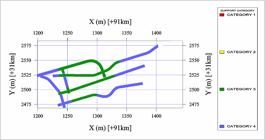Abstract
The creation of tridimensional models that represent the quality and geomechanical characteristics of the rock mass to be excavated can be made by using spatial interpolation techniques. The aim of this research is to improve the safety in underground activities, as well as to spread and popularize the use of spatial interpolation methods to represent both the spatial continuity of the quality of the rock mass and the geomechanical variables through geostatistical methods. This article presents and demonstrates the viability of using Q-System block models estimated from the borehole data for previous classification of the rock mass surrounding the underground excavation and rock support design. The block model for the support design of galleries is justified because it allows to previously forecast the kind and quantity of support necessary for the stability of the excavation, as well as the costs with these devices, besides increasing the safety in the operations. Techniques of indicator kriging and ordinary kriging were used to build the Q-System index block model. The model was validated through the techniques of visual inspection and cross validation. The data used in this study were collected from the geotechnical description of 39 borehole core samples with a total measurement of 4,015 meters in Fazenda Brasileiro Mine, located in the town of Teofilândia, Bahia State, Brazil.
Keywords:
geostatistical; block model; drill core; rock support design; rock mass quality

 Thumbnail
Thumbnail
 Thumbnail
Thumbnail
 Thumbnail
Thumbnail
 Thumbnail
Thumbnail
 Thumbnail
Thumbnail
 Thumbnail
Thumbnail
 Thumbnail
Thumbnail






